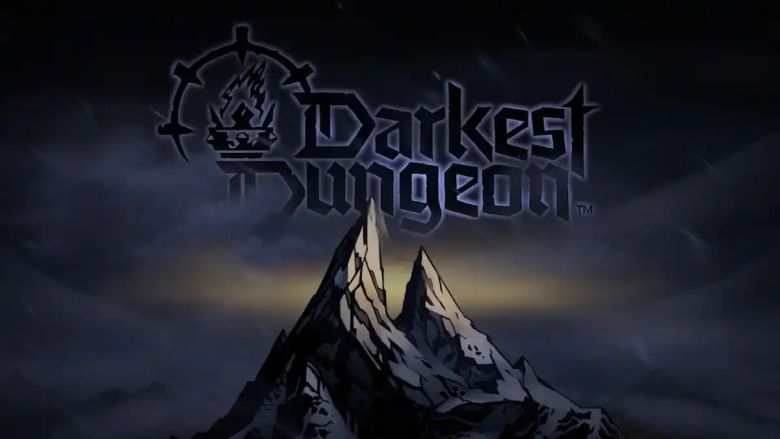

Darkest Dungeon 2 Sample Full Run (YouTube)
This is a short overview for the game Darkest Dungeon 2, released by developer Red Hook Studio in 2023 after a lengthy period in Early Access. Darkest Dungeon 2 is the sequel to the cult classic Darkest Dungeon which attracted an underground following as an indie game based on its gothic horror atmosphere and its brutally tough difficulty. Darkest Dungeon 2 makes some significant changes from its predecessor by shifting the genre from a persistant RPG where characters would carry over from dungeon to dungeon into a roguelike game where each run largely stands alone as a unique venture. This was a wise decision as Darkest Dungeon 2 manages to shed (some of) the heavy grinding associated with the first game while preserving and improving upon most of its best features. This is still a very difficult game and the developers seem to have gone out of their way at times to make things deliberately obtuse or frustrating for players just so that they will fail. However, once the player understands how the mechanics work and unlocks all of the available content, Darkest Dungeon 2 becomes an excellent roguelike experience marred only by dragging out for an unnecessarily long length of time. This is one of the best games of this type released in recent years and well worth playing for its Lovecraftian aesthetic alone.
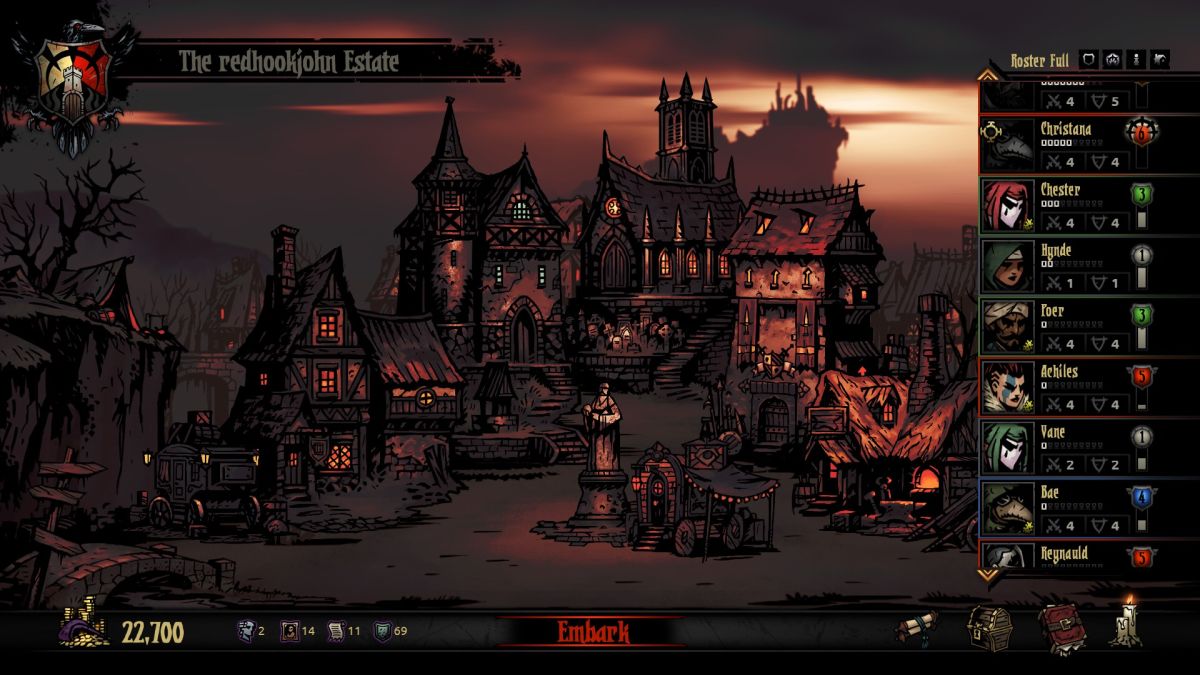
The original Darkest Dungeon was an indie project created by a small group of developers who were just getting started in the business. They had a fantastic core idea of creating a game based around eldritch horror run amok, with characters of various different classes arriving at this rundown estate and needing to venture into the dungeons below to confront monsters and return with treasure. Darkest Dungeon was organized around the concept of this estate and gameplay focused on upgrading the estate over time with various improvements based on the loot obtained in the dungeons. Individual characters also needed to be upgraded, in terms of their weapons and their armor and their skills, plus their various diseases and mental breakdowns needed to be attended to. Keep in mind as well that this was a game with perma-death so any character that happened to perish in a dungeon would lose everything invested in them forever. Even though more characters could always be recruited through the wagon, one unlucky dungeon crawl could set the player back hours and hours of time invested.
The net effect was that Darkest Dungeon was a game heavily focused on grinding. There was simply no way around this: the estate took forever to upgrade, the characters took forever to upgrade, and the game deliberately dragged out this process further with a cripplingly-small inventory that often made it impossible to carry all the loot back to town after a successful dungeon run. Some players loved the slow, methodical nature of the gameplay but it never quite sat the right way with me. I don't think that heavy grinding plus permadeath plus RNG-swingy combat makes for a particular fun combination as much of the time it felt as though I was running on a treadmill when playing this game, making progress in one area only to lose it in another area. It was a real shame because I wanted to like Darkest Dungeon so badly: the tactical combat was a ton of fun and the developers had created a unique art style that really worked to set the proper mood. It was clear that the initial game was missing something, with a great overall concept but not the best execution. If I can make a really old NES comparison, the original Darkest Dungeon was a bit like the original Mega Man, an amazing concept that clearly needed some more polishing and refinement before it could become a true classic.
I was therefore highly pleased when I heard that the sequel game was planning to shift over to a roguelike setting, something that felt like a much better fit for the gameplay. Rather than needing to upgrade each character over and over again in tedious fashion, each run would start out fresh. Similarly, suffering a total party wipe wouldn't lead to any negative consequences beyond having to start over from the beginning once again. This decision immediately removed much of the grinding from Darkest Dungeon 2 and made it much more approachable to newcomers. No longer would players have to grind through dozens and dozens of underground areas before they could even have a chance at taking on the Darkest Dungeon, now they could reasonably hope to beat the game on their first try if they played well enough and got a bit lucky. This shift in genre has been met with some pushback from fans of the original game but it's a massive improvement as far as I'm concerned.
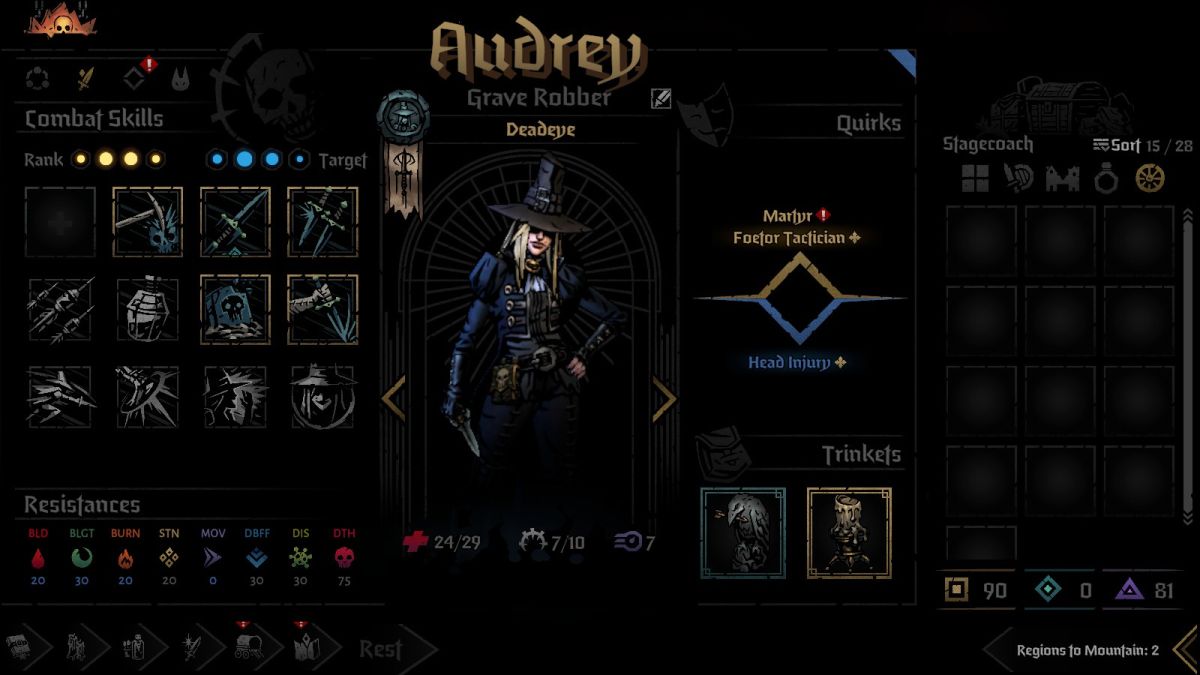
As mentioned above, players start out each run of Darkest Dungeon 2 by choosing their team of four characters before setting out in the wagon. There are eleven main heroes in Darkest Dungeon along with the semi-secret Bounty Hunter class which provide a tremendous amount of replayability by mixing and matching their various abilities together. Each character comes with their own distinct base stats along with eleven skills of various types to pick between. These skills have all sorts of different properties, ranging from your basic damaging skills to bleed/burn/blight damage-over-time effects to healing abilities to buffs/debuffs to enemy stuns and just about everything in between. You can only choose to have five skills active at one time on each character which can make for some very tough decisions about what to bring into combat. Testing out all of the various different skills and seeing which ones work the best is one of the most fun aspects of Darkest Dungeon 2's gameplay.
Characters further modify their skills by choosing one of several different available paths. These have to be unlocked ahead of time between runs but eventually provide even more options to customize how each hero will be played. For example, the Grave Robber can take the Deadeye path that improves ranged skills at the cost of weakening melee skills, the Venomdrop path that focuses on inflicting blight damage, or the Nightsworn path that emphasizes stealth at the tradeoff of decreased maximum health. There's always the option to take the default Wanderer path but the alternate paths generally make things more fun by dialing up one particular aspect of each character in exchange for some kind of penalty elsewhere. I remember one run where I didn't roll any tank characters and wound up playing the Highwayman as a Yellowhand, sacrificing damage for extra health and more supportive skills. This was a smart addition on the part of the developers that goes a long way to keep the gameplay feeling fresh across different runs.

All of the various skills in Darkest Dungeon 2 are linked together through the use of a common token system. The gameplay consistently uses the same symbols to help manage what would otherwise be an overwhelming amount of information about how various skills function. Gone are (most) of the big dice rolls from the original game, replaced with skills that always hit their target and deal their effects unless interrupted by some kind of token. Frequent tokens include shields that reduce incoming damage by half, dodge tokens that grant 50% odds to dodge the next blow, attack tokens that increase the damage of the next attack by 50%, and so on. These tokens make it vastly easier to keep track of what's going on in combat while also dialing down the somewhat extreme randomness that characterized the original Darkest Dungeon. When you see a crit token on a monster, you know that you need to disable that target or direct its attack towards a shielded character or else you're going to be in for a world of hurting. This system can be tricky to understand at first but soon will click with the player, afterwards making it easy to tell at a glance what's going on in any fight and react appropriately. It's one of those things that seems so intuitive in retrospect that playing the original Darkest Dungeon now feels painful due to its lack thereof.
The manor house from the first game and the hostile environments lurking beneath it have been replaced by the wagon in Darkest Dungeon 2, a horse-drawn coach that carries the party from place to place. Players must traverse three total regions before making their way to the Mountain for a final boss confrontation. There's a map on the left hand side of the screen that shows the road ahead with its branching paths and the player must navigate the wagon from location to location which effectively serve as a system akin to the beacons from FTL. The map starts out partially revealed which means that unless the party visits a watchtower they'll never know precisely what might be crouching in wait up ahead. Mostly there are battles of various kinds dotted all over the map along with road hazards that damage the wagon, "loathing" that builds up and has to be removed via combat, plus various events that serve as this game's version of the curios from the first game. Sometimes they provide additional supplies for the group, sometimes they result in additional stress or negative personality traits, sometimes they even result in dangerous additional battles against cthonic opponents. Navigating across the map is an important skill in this game that requires players to know which places they need to visit and which areas they can safely skip.

Combat itself mostly functions similarly to how it went in the original Darkest Dungeon, with each character limited by which skills they chose to take in battle and which of the four positioning slots they find themselves standing in. Most skills only function from certain party slots and enemies that move your characters out of position can be immensely damaging as a result. Aside from the addition of the token system, the biggest changes to combat involve dialing down the prevalence of heals and stuns which were completely out of control in the first game. Stuns are now very rare and not something seen very often while most healing abilities can't be used unless a party member is below a certain health threshhold. For example, the Plague Doctor's Battlefield Medicine skill will only heal a party member if they're below 50% max HP, otherwise it only removes bleed/blight/burn effects. Stress removal skills usually function in the same way, failing to have any effect unless the target has at least 5/10 stress accumulated already. Healing skills also function on a percentage basis, restoring for example 25% of max HP, rather than having flat values which serves as an innate balancing effect. These changes help keep healing and stun skills from completely dominating combat and overshadowing everything else as they tended to do in Darkest Dungeon.
The monsters look great in this game with their fresh coat of 3D paint and each of them has a surprisingly large number of potential actions in their moveset. Rare are the opponents that can only do one thing as opposed to having two or three or four different potential choices. If there's a downside to this, it's the fact that the total number of enemies is relatively small in this game and they start repeating a bit faster than I would have preferred. Monsters will roll with upgraded stats the further the party makes it into the run and can also gain one-off extra abilities at the start of each battle to shake things up further. Players will also need to defeat at least one of the four major bosses hiding out in their Lairs or else they can't access the final boss at the end of the game. Each of these are tough foes that will almost certainly cause game overs on the first couple attempts until the player learns how to work around their boss abilities. Several of them can actually be beaten without too much trouble but only by knowing certain boss mechanics which are never explained ahead of time. Darkest Dungeon 2 is very much like that in its gameplay, deliberately withholding information and expecting the player to fail until they manage to teach themselves the unintuitive solutions.
It's also worth mentioning the concept of death resistance which is a new feature in the gameplay. Heroes and some monsters don't die upon hitting zero health in this game, instead entering a state known as Death's Door. At this point any additional damage taken has a chance to kill them based on their death resistance; anything that doesn't kill them will lower their resistance and make it easier for future damage to finish them off. Player characters typically start with roughly 80% death resistance so hitting zero health usually won't defeat them instantly... but then again, you always have that 20% chance for the character to suffer permadeath for the rest of that run. Better to keep them out of that state in the first place if possible! Enemy bosses will often take several hits to cut through their death resistance and finish them off for good; damage-over-time effects tend to be particularly good in these cases since they count as an additional hit. It's a great overall system to take some of the randomness out of the combat which the original Darkest Dungeon was notorious for having. No more getting slapped with a random crit and suddenly losing a character to permadeath out of nowhere as it takes at least one additional blow on zero health to be finished off.
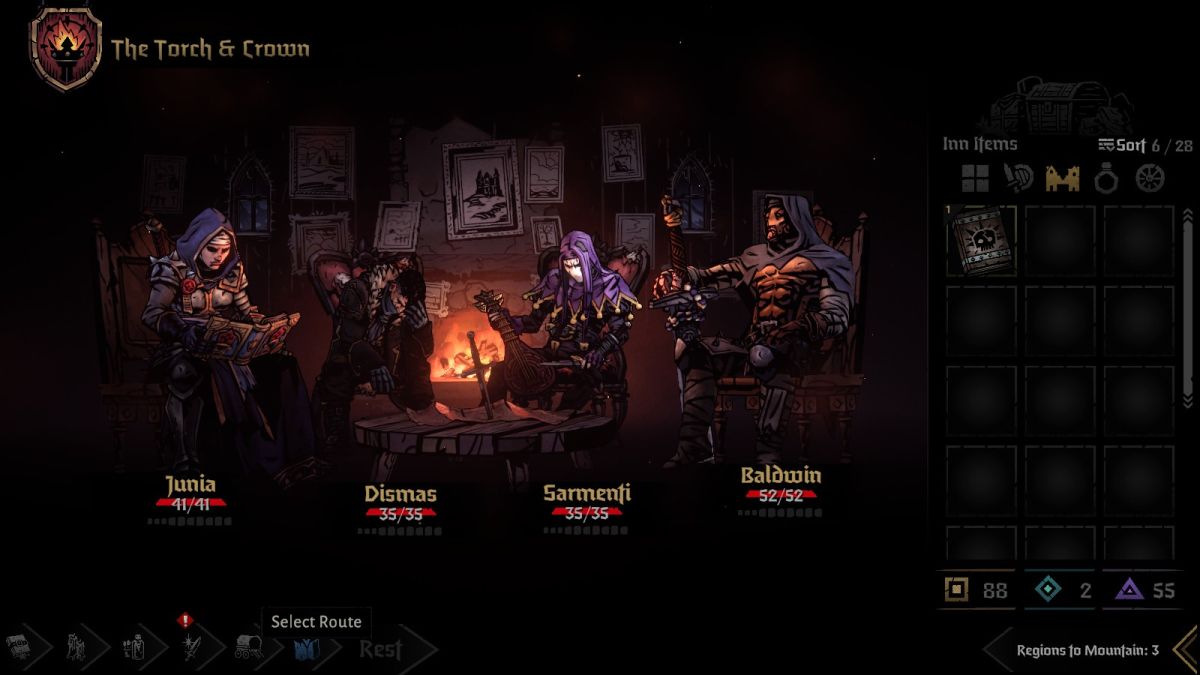
When the party isn't traveling in the wagon or battling monsters at the various encounters along the way, the group has a chance to pause at various different inns located between each region. Much of the critical gameplay associated with each run takes place at these inns where the player has to decide how to spend their accumulated money, pick which skills to upgrade into more powerful forms, choose how to outfit the wagon, and so on. There are two main currencies in Darkest Dungeon 2, relics and baubles, each of which can only be spent on certain types of goods. Relics are the more standard currency, used to purchase various different types of items at the inn and occasionally at Hoarders encountered out on the map. Many of these items are usable only in combat where they could have some kind of healing effect or remove a status effect or deal direct damage to the enemies. Each of your characters can only hold one item at a time which is one of the game's stricter limitations and forces some tough choices about what to bring. I usually try to get as many healing items as possible since I've found these to be more useful than stuff that deals even more damage to the monsters.
Relics can also be spent on special items that can only be used at the inn which is one of the more unique aspects to Darkest Dungeon 2's gameplay. Many of these inn-based items will grant some kind of temporary effect to an individual character that lasts until the next inn. It could be additional resistances or extra max HP or the chance to start each round with additional tokens that grant extra damage or more shields and so on. Some of the inn items can reduce stress or cure disease or permanently remove negative quirks from individual heroes. Many of them also boost the relationships between characters which I've found to be one of the best ways to spend relics; more on the relationships in a little bit. The player almost never has enough money to purchase everything that they want and the inn items are a frequent way to spend more relics even if everyone already has all of the in-combat items that might be needed.

The other currency of baubles is used to purchase items that have more permanent effects: trinkets for the heroes and gear for the stagecoach. Trinkets are essentially your weapons and armor for the characters, stuff that they can equip with various sorts of bonuses that also typically have a negative side effect as well. Trinkets start out pretty weak with modest stat bonuses but eventually players can unlock extremely powerful options that have far-reaching gameplay effects, stuff that can instantly cure all damage-over-time effects or grant 75% additional max HP or even add an additional turn for the character under the right circumstances. Each hero also has three unique trinkets that only they can use, many of which are insanely powerful if the appropriate conditions are in place. One of the most important tasks for any party to achieve is upgrading their trinkets over the course of the run; a well-equipped group is vastly stronger than one just starting out with nothing in the trinket slots. Each character can only equip two of them at a time though which can often be frustrating when there's a bunch of stuff that the player wants to give each hero.
Baubles can also be spent on purchase stagecoach upgrades, various passive stat bonuses that apply to the whole party. These fall into different categories and include things like increased chance for positive relationships between characters, a chance to produce additional items at each encounter along the way, increased inventory storage capacity, and so on. Stagecoach items often have some kind of synergy with the various different pets that the party can choose to take along, ten different options that the player gets to pick between at the start of each run which are literally mounted on the side of the wagon. The wolf cub grants a chance to resist stress that goes up for each luxury stagecoach item equipped, for example, while the reanimated rabbit grants additional speed for each food gear item and bonus max health for each consumable food in inventory. The pets are another way to further customize each new venture, whether synergizing with the gear already present on the wagon or simply heading off into wacky variant land.
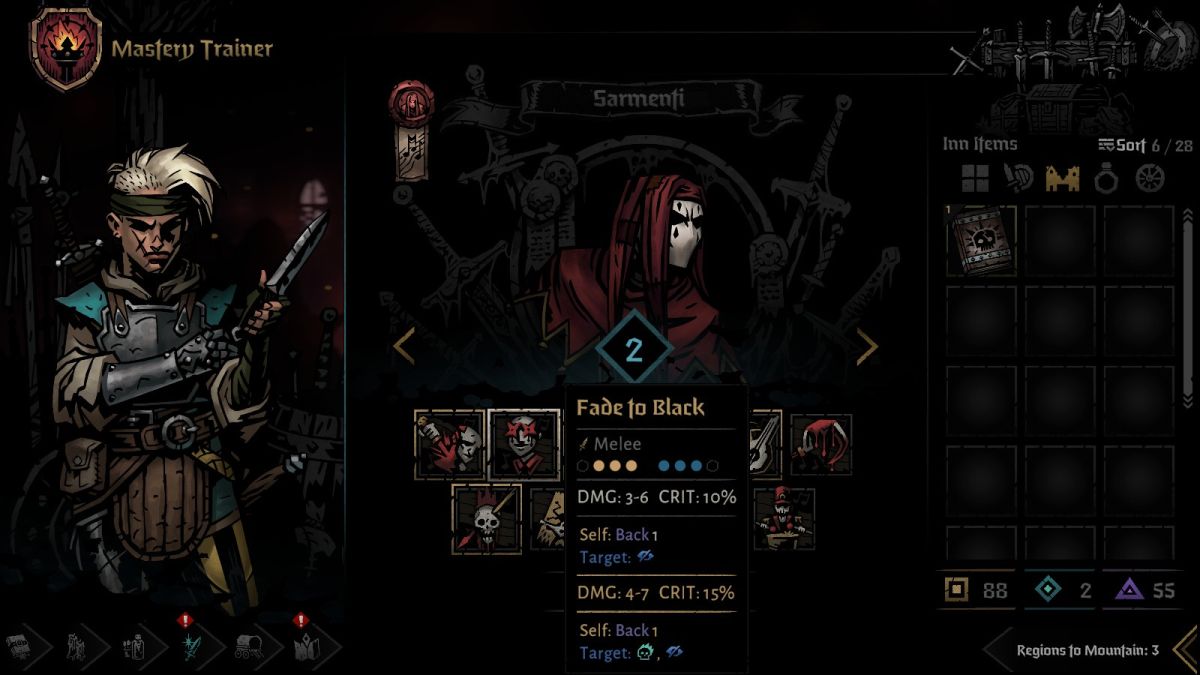
Characters can also be upgraded at the inn through the use of mastery points, technically the third currency in Darkest Dungeon 2 although a much more limited one because it can only be used to upgrade skills. Winning tough battles or clearing out creature dens will grant the party mastery points which can be cashed in at the inn to improve individual character skills. Every skill in the game becomes better in some regard, whether that's increasing its damage output or adding extra new effects that weren't present before. Some skills become vastly better once they've been upgraded, like the Jester's Fade to Black suddenly applying a Combo token on each hit or the Vestal's Sanctuary skill removing two stress points which it completely lacked before. The party always gets two mastery points to spend at the very first inn and picking which skills to upgrade is another very tough decision; much of the gameplay across the first region or two tends to be a scramble for as many mastery points as possible since the upgraded skills are so powerful. Each skill can only be upgraded a single time though which removes the tedium from the original game of needing to upgrade each skill over and over again. The mastery system is a really smart gameplay mechanic that fits perfectly into the limited resources available over the course of a rougelike game's individual runs.
Finally the inn is also the place where the personal relationships between the characters prove to have their own gameplay effects. Each character has a numerical relationship score with the other three characters in the party, with six total relationships possible across the four heroes. These can go up or down over time based on the decisions that the player makes at the various events encountered during the course of the run; since this is Darkest Dungeon we're talking about, those numbers will mostly go down absent intervention on the part of the player. Before entering each new region, each of those six character relationships has a chance to produce a positive bond or a negative bond which will last for the entirety of the next region. Positive bonds are incredibly helpful to have, as they grant bonus effects when using skills that could remove a point of stress, remove a damage-over-time effect, grant a dodge or shield token, or even heal one of the characters for 10% of their max HP. I've had runs where the tank character kept getting healed every turn for free and it made things immensely easier, let me tell you.
Conversely, if those personal relationship drop down into the negative zone, it's also possible for negative bonds to form which have exactly the opposite effect. You can have characters debuffing one another's attack or defense, or even adding extra stress points to other party members simply from using one of their own skills. In fact, the negative bonds are so bad that this is the main penalty for characters maxing out the stress meter: their health drops down into the critical range and they get a big -3 relations penalty with everyone else. It's very, very easy for newcomer players to get trapped in a death spiral of negative relations and lose their early runs that way. I've found that it's extremely important to prioritize the relationships between characters and I tend to spend almost all of my relics on inn items that boost relations in some way. This is a critically important part of the gameplay and the player really has to work to build those feelings between heroes. It's worth the effort in the end and often makes the difference between success and failure.

Even though Darkest Dungeon 2 has switched over to a roguelike format, the developers still apparently wanted players to have to do a good bit of grinding as there are a ton of things that must be unlocked in this game. Unlocks are handled via another currency known as candles which hold no function during the course of an individual run and can only be used to purchase various unlocks in between different party selections. Only the default initial four heroes start out unlocked with the other eight characters requiring candles to add to the team. Each hero can then gain various boosts to their base stats by spending additional candles as well as unlocking their three additional paths which are initially unavailable; it takes about 60 candles to fully unlock each character and a typical run will only bring back a dozen or two candles when first starting out. It's a process that will take quite a while to have all of the heroes available and unlocked to their full potential.
Those are just the characters though, only one out of five different areas where candles can be spent. Most of the items in Darkest Dungeon 2 also have to be unlocked, between combat items and trinkets and stagecoach gear and so on. There's something like 150 of these items in all which each require more candles to be added to the pool of stuff that can be found out in the dungeon. The upgraded items also make a very big difference in terms of success or failure; to take one example, there are a few initial combat items that will heal a character for 10% of their max HP and remove either bleed/blight/burn status depending on which damage-over-time effect is in place. The bandage can also only be used on a character who's already bleeding which tends to limit its effectiveness. Once everything has been unlocked, the top-tier healing item restores 75% of a character's max HP and doesn't require them to be bleeding or whatever to be used. Do you think defeating some of the lair bosses might be a tad bit easier once that kind of item has been unlocked? It's almost impossible to defeat the game when starting out until some of these more powerful gear options have been opened up.
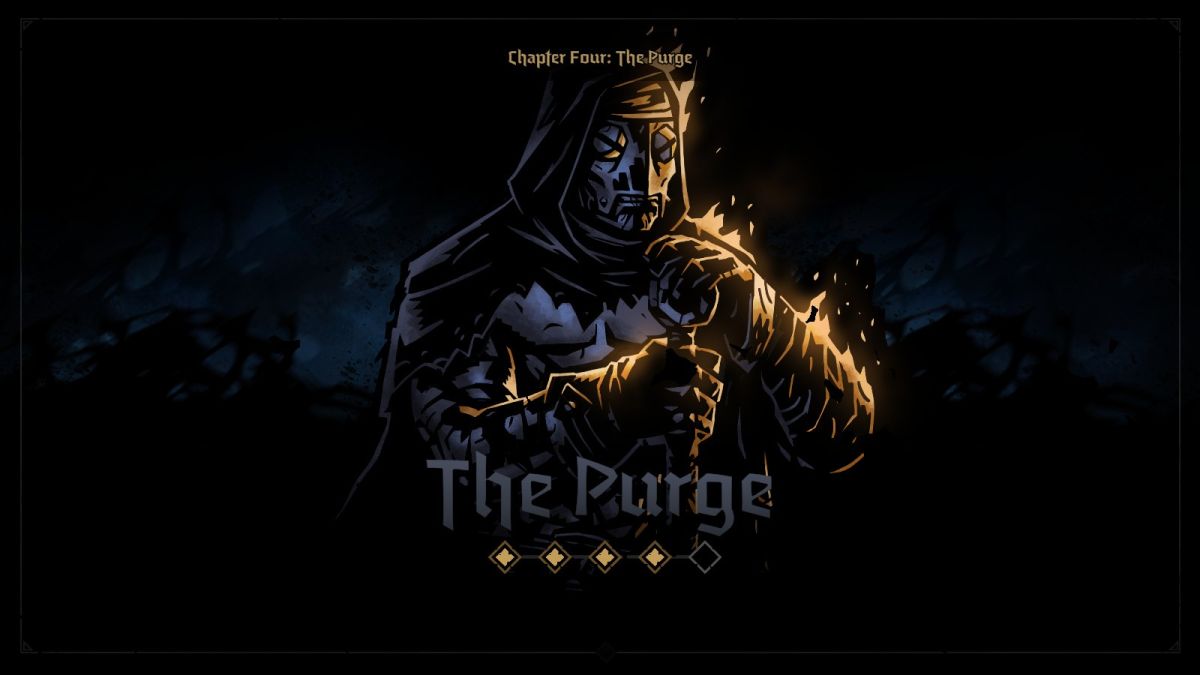
Then there are also various base stats of different kinds that also take hundreds more candles in total to unlock. The wagon alone has something like two dozen different unlocks and all of them are more or less mandatory to play the game; it's vastly easier running the wagon once there are four gear slots as opposed to the default one allowed piece of stagecoach gear, and the inventory limit is raised from 20 slots to 28 slots. The pets also have to be unlocked and they provide additional much-needed benefits once they've been enabled for each run. There are even hundreds and hundreds of candles to be spent on purely cosmetic unlocks, alternate skins for the stagecoach and each of the heroes, though these can be skipped to the end of the unlocking process and are more of a fun extra than anything else. In every other area though, Darkest Dungeon 2 requires a painfully long sequence of candle grinding to have all of the various tools available for use by the party. I found the game to be significantly easier and much more fun to play once the unlocking process was finally complete (after something like 100 hours of time invested).
The best party of the unlocking system comes in the form of the individual hero stories, unlocked by visiting Shrines of Reflection out in the various regions while playing the game. These shrines reveal the background of each character through a series of narrated stories and simultaneously unlock additional skills for each character at the same time. Yes, each hero only begins the game with five skills available and all of the other skills have to be unlocked via repeated visits to these shrines. This rarely feels like a chore though because the background stories for each character are so entertaining, not least due to the amazing voiceover work of Darkest Dungeon's narrator. Two of the five shrine visits also prompt some kind of combat scenario for each character which always ties into their background. These get extremely creative and include things such as the Plague Doctor debating against her instructor, the Runaway lighting fires with unintentional side consequences, and the Grave Robber poisoning her husband with a tainted goblet. Most of these are fairly simple to complete and only a couple of them proved to be frustrating due to unexplained rules that required trial-and-error to complete (the Jester in particular has an obnoxious story event that took me many tries to finish). Overall though, it's an amazing system for unlocking skills and practically a tutorial in game design on how to combine narrative and gameplay together effectively.
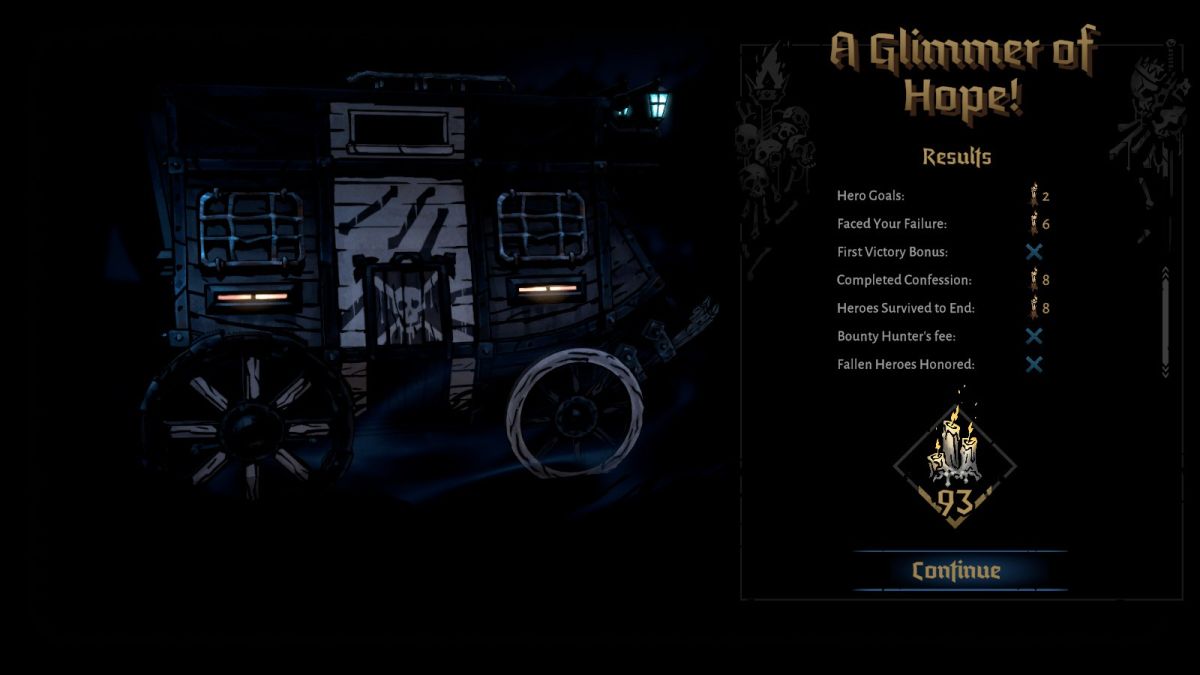
Aside from the grinding nature of the unlock system, the single biggest issue with Darkest Dungeon 2 is the deliberately unfair nature of its design. The developers clearly went out of their way to make certain things unintuitive and frustrating to new players, consciously wanting them to lose in certain places due to gameplay mechanics that they couldn't possibly have known about ahead of time. For example, there's a very common battle against cultist enemies consisting of one Altar, one Evangelist, and one Deacon. This battle must be fought by defeating the enemies in that exact order: first the Altar, then the Evangelist, then the Deacon. Any other order doesn't work because the cultists will simply heal one another back to full health, including removing any damage-over-time effects in the process. Nothing about this sequence is explained by the gameplay, the party simply must learn the "correct" order by playing the game over time and then act accordingly. Darkest Dungeon 2 is packed from beginning to end with this sort of fake difficulty and there's no way to avoid failing during the player's initial runs until they learn all of the various unexplained tricks along the way. The final boss for Confession 3 is an egregious example of this, an opponent where the standard rules for combat are completely thrown away and replaced with an entirely new system with no warning ahead of time. And if you mess up at all, which you will on the first try, you get to start all over again from the beginning of another four hour run. The whole boss fight is so obnoxious that the player base has largely skipped over Confession 3 and stuck to the other confessions since everyone hates the boss design so badly.
Darkest Dungeon 2 also suffers from a real sense of drag in the later stages of its gameplay. The runs quite frankly take too long to complete, usually running about 3-4 hours which is an uncomfortable amount of time, often too long for a single session but not long enough for a true multi-session setup like a traditional RPG. It's very common for the party to have all their core skills upgraded with mastery points, to have powerful trinkets equipped in each slot, with plenty of combat items available in inventory... and the game just keeps on going even though there's really nothing more to be done. Imagine if FTL had two more sectors to get through instead of being perfectly calibrated on its length, that's often where Darkest Dungeon 2 finds itself. Gameplay is also dragged out by having too many road encounters between the event beacons, battles that typically take a couple of minutes to complete yet often result in completely pathetic loot payouts. What is the purpose of having additional combats that aren't challenging to a fully-kitted party and don't yield anything worthwhile in terms of rewards? It's a shame that the gameplay lags so noticeably in this regard since the rest of the game is so well designed. If the last two regions were 60 leagues in length instead of 80 leagues in length, I think the gameplay would have been better calibrated.
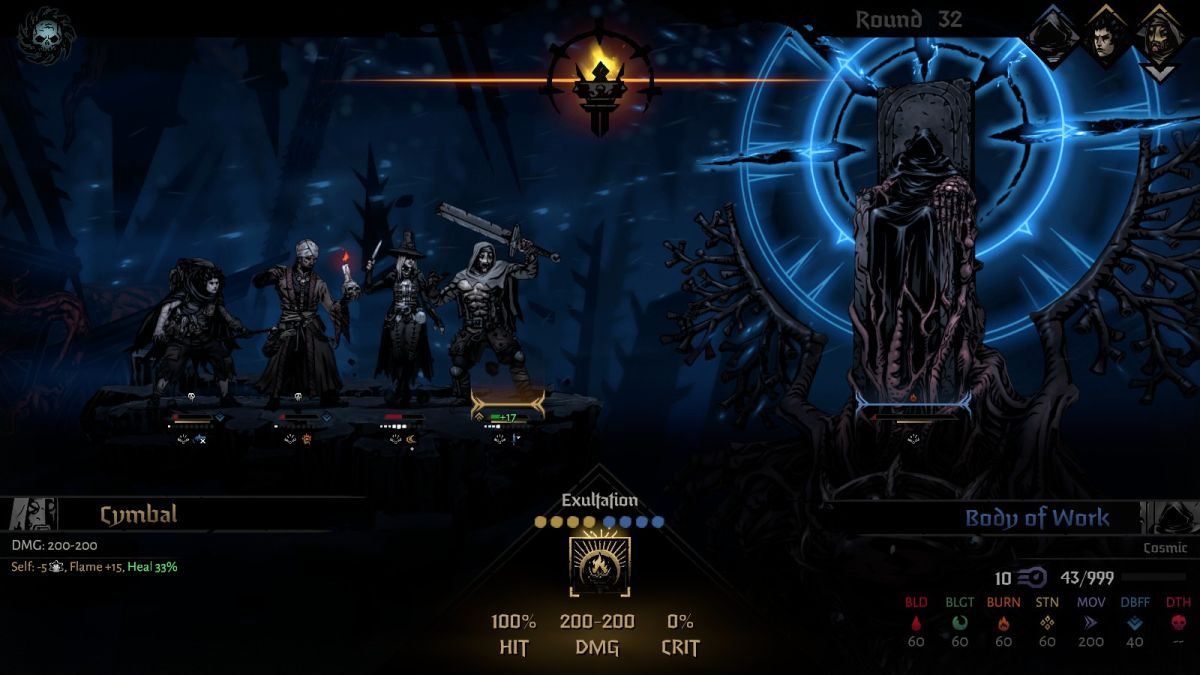
For all of its frustrations, Darkest Dungeon 2 is an excellent game and well worth purchasing for anyone who enjoys roguelike titles. It's arguably worth picking up even for those who aren't big fans of roguelikes for its atmospheric horror setting and truly awesome in-combat gameplay. I found myself having the most fun once everything was unlocked and I could simply roll a completely random party followed by trying to make the group work together in practice. There are even additional challenge features for those who have completed everything in the core game: "memories" that can be applied to heroes to carry over some of their stats across more than one run and special "blue flame" torches that add additional difficulty on top of the normal challenges. For example, one of the blue flames makes it basically impossible to have any positive bonds between characters while another one causes any monster corpses on the ground to transform into carrion creatures at the start of each round. These features add even more replayability for expert players and I can attest that they make a tough game even harder to complete. While I don't think the total package comes together quite as well as FTL, this is still a fantastic game that I expect to be playing for many years yet to come.



